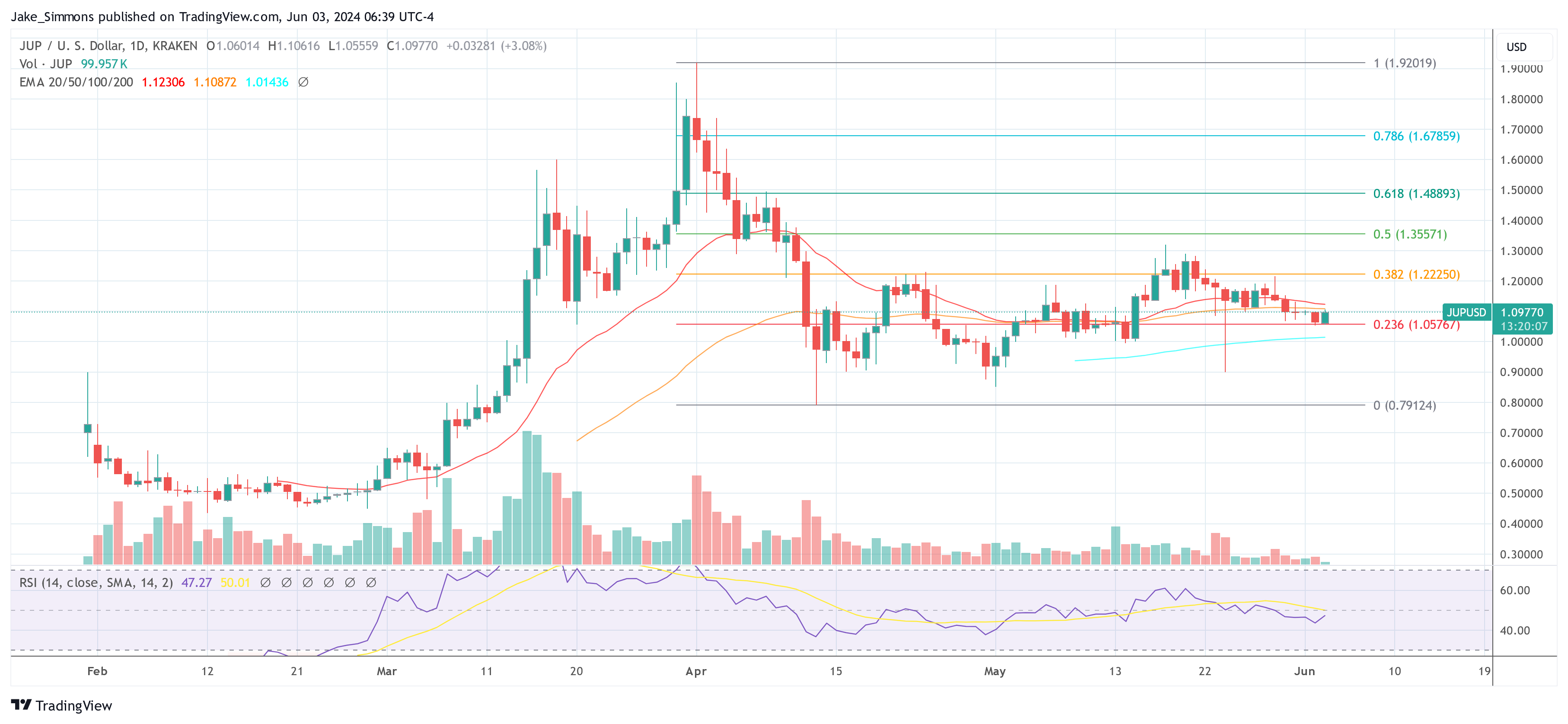Crypto Guru Unveils Best Altcoins To Buy Now
In a recently published video titled “Best Altcoins To Buy Now,” crypto influencer Lark Davis shared his latest insights on promising altcoins with his 546,000 YouTube subscribers. Known for his candid and straightforward approach, Davis emphasized the speculative nature...

In a recently published video titled “Best Altcoins To Buy Now,” crypto influencer Lark Davis shared his latest insights on promising altcoins with his 546,000 YouTube subscribers. Known for his candid and straightforward approach, Davis emphasized the speculative nature of his recommendations and the inherent risks of crypto investments.
Davis began by acknowledging Bitcoin’s role as the premier digital store of value, noting that while it remains the most secure asset in the crypto space, it is unlikely to deliver the high returns that some altcoins can offer. “If you’re after life-changing gains, then you have to risk life and limb in the altcoin jungle,” Davis remarked, underscoring the potential of altcoins to yield substantial returns, albeit with significant risks. He pointed out that Bitcoin, while being a solid choice for wealth preservation, probably won’t deliver 100x or even 10x returns in the near future.
The approval of spot Ethereum ETFs is a significant development that Davis believes will bring attention to other altcoin projects, setting the stage for a broader “altcoin season.” He acknowledged that while memecoins often gain the most attention during these times, other projects with real utility deserve closer scrutiny. Davis expressed his intent to highlight coins with actual use cases, as these have better chances of surviving market cycles and potentially achieving long-term success.
The first altcoin Davis highlighted is Jupiter (JUP), a decentralized exchange (DEX) aggregator built on the Solana blockchain. Jupiter stands out due to its ability to consistently offer the best token prices by aggregating data from multiple exchanges. Davis emphasized the importance of Jupiter’s user-friendly interface, which simplifies the onboarding process for new users entering the DeFi space. This ease of use, combined with Solana’s recent popularity driven by memecoins, positions Jupiter as a key gateway for traders looking to capitalize on emerging trends.
Davis detailed Jupiter’s significant trading volumes, noting that it frequently surpasses Uniswap. In March and April, Jupiter achieved $47 billion and $35 billion in trading volume, respectively. He highlighted Jupiter’s perpetual exchange feature, which offers up to 100x leverage, as a significant attraction for traders seeking substantial gains. Moreover, Jupiter’s staking rewards model incentivizes participation in project governance, providing stakeholders with additional benefits such as incentivized tokens, launchpad fees, and airdrops. Davis mentioned Jupiter’s plans to expand into the forex and stock markets, which could further enhance its utility and market position.
Next on Davis’s list is Aerodrome (AERO), a DEX operating on Coinbase’s Base ecosystem. Davis underscored the strategic advantage of having Coinbase, with its extensive user base of over 120 million, backing the Base ecosystem. This support, combined with the upcoming introduction of smart wallets to simplify user onboarding, gives Aerodrome a significant edge. Although there is no native token for the Base ecosystem yet, Davis believes Aerodrome’s token could serve as a viable alternative, benefiting from its role as a major DeFi platform within the ecosystem.
Davis pointed out Aerodrome’s impressive total value locked (TVL) of around $700 million and a market cap of approximately $500 million. He suggested that as more Coinbase users engage with the Base ecosystem, the Aero token could see substantial appreciation. Davis revealed that he has increased his holdings in Aerodrome, confident that the platform’s growth potential aligns with his investment strategy.
Davis also discussed SubSquid (SQD), describing it as the “Google of blockchains.” SubSquid is a comprehensive blockchain indexing solution designed to facilitate quick and cost-effective access to on-chain data. Davis explained that SubSquid acts like a decentralized filing cabinet, organizing data from multiple blockchains to enable developers to build decentralized applications (dApps) without the burden of slow queries. Supporting over 100 networks and utilized by more than 5,000 dApps, SubSquid offers a robust infrastructure for blockchain development.
With a total token supply of 1.34 billion and a market cap of around $21 million, SubSquid presents a compelling investment opportunity, according to Davis. He compared SubSquid’s market position to that of The Graph (GRT), which boasts a market cap of $3 billion, suggesting that SubSquid has significant room for growth. Davis mentioned his participation in SubSquid’s private sale and his current holding strategy, watching for the project’s development and market performance.
The Oasis Network (ROSE), a layer-1 blockchain focused on privacy and scalability, was another recommendation. Davis highlighted its unique two-layer architecture, which separates consensus and smart contract execution to enhance privacy and scalability. This structure makes Oasis suitable for applications in finance, artificial intelligence (AI), and the metaverse. Davis emphasized the importance of privacy in blockchain applications, especially for attracting institutional users. He likened Oasis’s approach to Polkadot’s independent parachains and Avalanche’s subnet infrastructure.
Davis pointed out Oasis’s robust ecosystem fund, supported by prominent investors such as Binance Labs, Pantera Capital, and Jump Capital. The network’s ongoing rebrand aims to emphasize its focus on decentralized AI, aligning with current market narratives. Collaborations with projects like the Ocean Protocol and the involvement of notable figures in AI further bolster Oasis’s credibility and potential. The native token, ROSE, has a market cap of around $600 million and a maximum supply of 10 billion coins. Davis disclosed that he acquired a significant amount of ROSE during the bear market and continues to monitor the project’s progress.
Finally, Davis discussed Fantom (FTM), a layer-1 blockchain designed to challenge Ethereum’s dominance. He highlighted the upcoming Sonic upgrade, which will transform Fantom into a new blockchain, replacing the original. This rebrand, accompanied by technical enhancements, could drive significant interest and investment in Fantom. Davis praised Sonic’s impressive transaction speed of 2,000 transactions per second and sub-second finality, noting that these features position Fantom as a strong contender in the blockchain space.
Davis revealed that he secured a substantial position in Fantom through an OTC deal and later doubled his holdings by purchasing more on Binance. He emphasized the potential of the Sonic upgrade to attract attention and investment, driven by the involvement of popular developer Andre Cronje. With on-chain statistics improving and renewed interest in the Fantom ecosystem, Davis remains optimistic about its prospects.
In closing, Davis reminded viewers of the speculative nature of crypto investments and the importance of conducting thorough research. “Just because I like these coins doesn’t mean they’re guaranteed to succeed,” he cautioned. Davis’s insights reflect the dynamic and high-risk environment of the cryptocurrency market, where informed decision-making is crucial.
At press time, JUP traded at $1.0977.
 Jupiter price hovers above the 0.236 Fib, 1-day chart | Source: JUPUSD on TradingView.com
Jupiter price hovers above the 0.236 Fib, 1-day chart | Source: JUPUSD on TradingView.comFeatured image created with DALL·E, chart from TradingView.com

 MikeTyes
MikeTyes 































